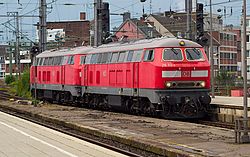DB Class 218

A pair of Class 218s at Köln Hbf, 2013.
|
|||||||||||||||||||||||
|
|||||||||||||||||||||||
|
|||||||||||||||||||||||
|
|||||||||||||||||||||||
| Type and origin | |
|---|---|
| Power type | Diesel-hydraulic |
| Builder | Krupp, Henschel, Krauss-Maffei, MaK |
| Serial number | 218 001-012 218 101–499 218 901-908 (converted DB Class 210) |
| Build date | 1968; 1971-1979 |
| Total produced | 12 prototypes 398 main production 1 as 218 399 rebuilt from 215 112 |
| Specifications | |
|---|---|
| Configuration: |
|
| • UIC | B'B' |
| Gauge | 1,435 mm (4 ft 8 1⁄2 in) |
| Length | 16.4 m (53 ft 9.7 in) |
| Loco weight | ~79.5 t (78.2 long tons; 87.6 short tons) |
| Prime mover |
As built: 218 001-012, 101-196, 242-288, 901-908: MTU 12V 956 TB 10 (of 1,840 kW or 2,470 hp) 218 198-241, 289-322, 340-426, 435-455, 463-484: MTU 12V 956 TB 11 (of 2,061 kW or 2,764 hp) 218 197, 323-339, 427-434, 456-462, 485-499: Pielstick 16PA 4V 200 (of 2061 kW) |
| Generator | 400 kW (540 hp) for HEP |
| Transmission |
Hydraulic (Voith 820 brs or MTU K 252 SUBB (with pielstick engines) Power transmission limit is 1487 kW |
| MU working | with other classes of the V160 family, and other locos |
| Loco brake |
hydrodynamic brake KE-GPP2R-H mZ |
| Performance figures | |
|---|---|
| Maximum speed | 140 km/h (87 mph) / 90 km/h (56 mph) |
| Power output | 1,840 kW (2,470 hp) (TB10 MTU) 2,061 kW (2,764 hp) (MTU TB11) (TB11 MTU) 1,986 kW (2,663 hp) (Pielstick) |
| Tractive effort | starting : 235 kN (53,000 lbf) |
The DB Class 218 (before 1968 the DB Class V 164) are a class of 4 axle, diesel hydraulic locomotives acquired by the Deutsche Bundesbahn for use on main and secondary lines for both passenger and freight trains.
The class represents the final major revision of the DB V 160 family of locomotives; having the preferred features of the antecedent locomotives, including a hydrodynamic brake, and a single engine providing electrical train heating via a generator as well as tractive power. The class were also the most numerous of the family, providing the backbone of the Deutsche Bundesbahn's main-line diesel locomotive traction from the 1970s up to the reunification of Germany.
Despite being displaced from many workings by DMUs, electrification, and inherited DR Class 130s, as of 2009 a significant number of the class still remain active throughout Germany.
The locomotives of series 218 were the last of the V 160 family to be developed; the main new feature was the use of a single engine to provide tractive power as well as electrical train heating when required (via an attached generator), the simplification over the two engined DB Class 217 was preferred, and was made possible by the availability of a higher powered (~1840 kW) engine compared to the original DB Class V 160 (~1400 kW).
In 1966 an initial twelve prototype locomotives were ordered from Krupp by the DB, for which the V 164 numbering was given, the main order came after the change to a 'computer compatible' UIC numbering scheme (See DB locomotive classification) which gave the number 218 as the reporting code for this class of locomotives.
The main series of 398 machines was produced between 1971 and 1979, by Krupp, Henschel, Krauss-Maffei and MaK. Additionally the engine DB 215 112, after being badly damaged in 1975 was repaired to Class 218 specification, and renumbered 218 399.
...
Wikipedia
